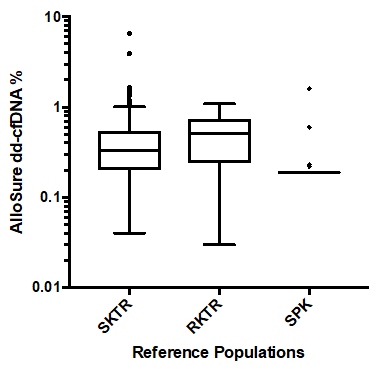Donor-Derived Cell-Free DNA for Surveillance in Simultaneous Pancreas and Kidney Transplant Recipients, Can We Extrapolate from Kidney Transplant Alone?
1Rush University Medical Center, Chicago, IL, 2CareDx, Brisbane, CA
Meeting: 2019 American Transplant Congress
Abstract number: D264
Keywords: Genomic markers, Kidney/pancreas transplantation, Pancreas transplantation
Session Information
Session Name: Poster Session D: Pancreas and Islet: All Topics
Session Type: Poster Session
Date: Tuesday, June 4, 2019
Session Time: 6:00pm-7:00pm
 Presentation Time: 6:00pm-7:00pm
Presentation Time: 6:00pm-7:00pm
Location: Hall C & D
*Purpose: Assessment and identification of early organ injury in Simultaneous Pancreas and Kidney (SPK) patients has clear clinical utility. This analysis was performed to establish clinical reference ranges for donor-derived cell-free DNA (dd-cfDNA) in SPK recipients, identifying the normal biological variation compared to kidney transplant recipients, both solitary (SKTR) and repeat (RKTR), as well as highlight the potential to detect events.
*Methods: 26 SPK transplant recipients with one paired dd-cfDNA result were identified a median 955 days (range 15 – 2097 days) post-transplant. Patients were compared to 202 SKTR a median 28.5 days (range 14 – 186 days) post-transplant, and 12 RKTR a median 37 days (range 14 – 165 days) post-transplant. 21 SPK patients had no clinical symptoms/signs of rejection and were deemed stable, with 5 patients classed as having an event based on assessment of clinical parameters. Documented SPK events included: allograft pancreatitis, acute rise in lipase, kidney biopsy confirmed ACR/AMR and de-novo or rising DSA. dd-cfDNA levels were compared between stable and acute SPK patients.
*Results: Stable SPK had median dd-cfDNA = 0.19% (IQR 0.19-0.19 95% CI 0.14-0.42), SKTR had median dd-cfDNA = 0.33% (IQR 0.2-0.55, 95%CI 0.39-0.55), with RKTR dd-cfDNA median = 0.51% (IQR 0.24-0.73 95% CI 0.31-0.70); Kruskal Wallis comparison between groups (p = 0.002), with significant overlap of 95%CI. The reference cut off was identified as 1.1% (97.5th percentile). Acute event SPK median dd-cfDNA = 0.59% (IQR 0.46-2.2, 95% CI 0.02-2.34), which was significantly elevated compared to stable patients (p = 0.004).
*Conclusions: Use of dd-cfDNA in SPK patients is a feasible concept with results demonstrating stable SPK patients have similar baseline dd-cfDNA to kidney transplantation and a reference cut off identified as 1.1% (97.5th percentile). It may be speculated that diminished SPK dd-cfDNA baseline may be related to the later time frame. Elevations in dd-cfDNA associated with clinical changes are significant. Further work on serial changes in dd-cfDNA are needed to better ascertain biological variation and pathological influences.
To cite this abstract in AMA style:
Olaitan OK, Loeb S, Hetterman E, Peev V, Saltzberg S, Hertl M, Dholakia S. Donor-Derived Cell-Free DNA for Surveillance in Simultaneous Pancreas and Kidney Transplant Recipients, Can We Extrapolate from Kidney Transplant Alone? [abstract]. Am J Transplant. 2019; 19 (suppl 3). https://atcmeetingabstracts.com/abstract/donor-derived-cell-free-dna-for-surveillance-in-simultaneous-pancreas-and-kidney-transplant-recipients-can-we-extrapolate-from-kidney-transplant-alone/. Accessed December 31, 2025.« Back to 2019 American Transplant Congress


